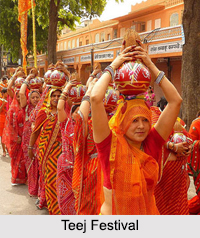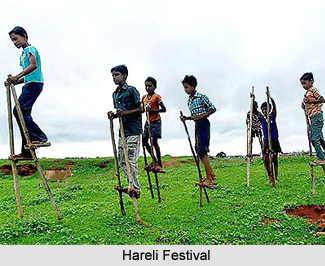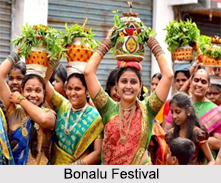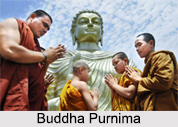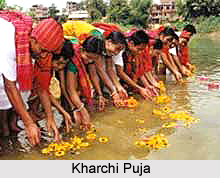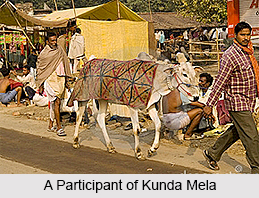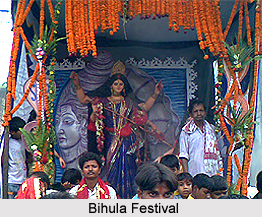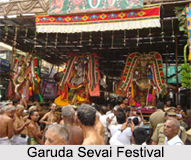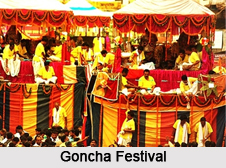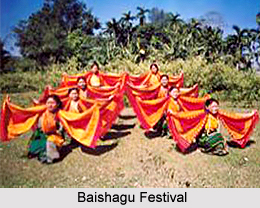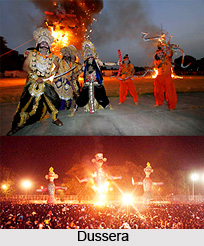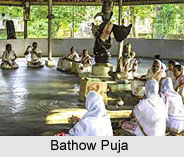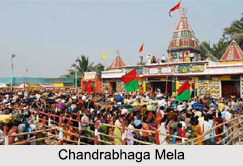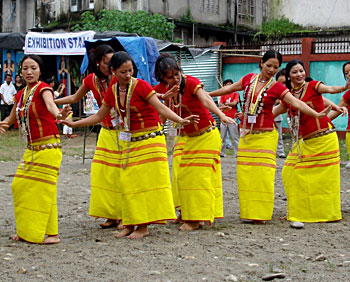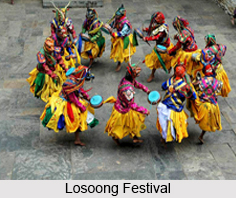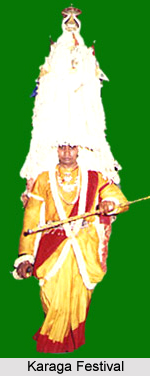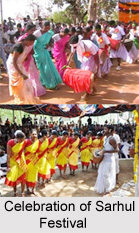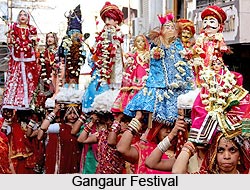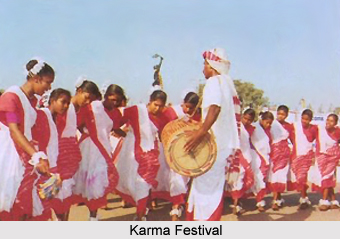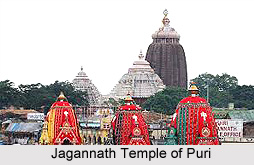 Nabakalebara is an ancient ritual in Oriya custom and culture that happens before Ratha Yatra. It is an ancient ritual associated with most of the temples of Lord Jagannatha, Subhadra and Balarama when the Idols of Lord Jagannath, Balabhadra, Subhadra and Sudarshan are replaced by a new set of idols made up of neem trunk.
Nabakalebara is an ancient ritual in Oriya custom and culture that happens before Ratha Yatra. It is an ancient ritual associated with most of the temples of Lord Jagannatha, Subhadra and Balarama when the Idols of Lord Jagannath, Balabhadra, Subhadra and Sudarshan are replaced by a new set of idols made up of neem trunk.
Occasion of Nabakalebara
A year with an extra in "Ashadha masa" month as per Hindu calendar is considered auspicious for conducting the ceremony of Nabakalabera. This usually occurs every twelve to nineteen years.
Construction of Nabakalebera
The deities of Lord Jagannatha, Balarama and Shubhadra are made from a special type of Neem wood known as Daru Bramha. Preparations for the ceremony start in the month of Chaitra. Last ceremony was done in the year 1996. The next ceremony will be held on 2015. More than 3 million devotees are expected to visit the temple during the Nabakalevara of 2015.
Protocols in Nabakalebara
According to different secret protocols, Nabakalebara followed from time immemorial in the temple, the provision is there for changing of the deities. As the deities are made up of Neem tree basically, along with Musk, Sandalwood and many other rare combinations, they undergo change of Vigraha before the adhika ashaadha ends. There are different agama shastra followed in other parts of India for Vishnu worship, such as Vaikhanasa also prescribe change of deities made up of wood under specific astrological combination. It is to be noted that the deities made of stone or metal need not be changed unless damaged, but the wooden deities are to be changed within specific gap of years and the supreme power must be installed from the old one to the new one, by secret rituals.
Using of Woods in Nabakalebera
No ordinary Neem tree can be used to make the deities. There are certain well defined criteria must be satisfied by the tree before it is labeled a Daru Bramha fit for deities making. As per long-standing tradition the Priests of the Jagannath Temple worship Mangala at the Kakatpur Mangala Temple. It is said the Goddess appears to them in their dreams revealing the location of the holy trees.
Transformation of Images of Lord Jagannatha
The elaborate rituals, numerous myths and several celestial incidents are attached to this auspicious affair. The exact procedures of the transformation of images have been mentioned in the Sanskrit manuscripts written on palm leaves which are kept in the temple. Only the three head priests of the temple have the sole responsibility of reading and interpreting them. As the images of Lord Jagannath must be made of wood, the priests must first locate an appropriate tree. Neem trees are used to carve out the images of Lord Jagannath. Now no ordinary Neem (Margosa) tree can be used for this purpose. The tree which will be used has to fulfill many conditions. Lord Jagannatha is dark in colour. So the neem tree from which his deities are to be carved out should be dark; whereas the trees which would be used for the deities of his brother and sister are lighter in color.
Rituals in Nabakalebera
Naba Kalebara of Lord Jagannath starts with the formation of the search party that would go out to locate the "Holy Tree". The search party consists of one member of the Pati Mahapatra family, twenty Dayitapatis, one Lenka, nine Maharanas, and sixteen Brahmanas, three Deulakaranas, thirty police officers and two inspectors of police.
Functions of Nabakalebera
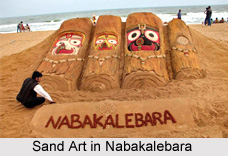 The function of Nabakalebera begins after the Big Midday Offering to Lord Jagannath. The blessings of the Lord are sought. A twelve foot garland called Dhanva Mala made especially for this day is offered to the lord and His siblings. After worshipping the Lord, the garland is given to the Pati Mahapatra family, who is meant to lead the procession. He would from then on carry the huge garland until the sacred tree is located. Upon spotting the tree the Garland is placed on top of a coconut and offered to the Tree. Apart from the garland, the robes of Lord are given to the descendants of Bitarachha Mahapatra family, Dayitapaties and the Pati Mahapatra who would tie it as a turban on their head while going on the procession. Both the garland and the clothes are significant in the sense that it is indicative of the Lord himself traveling with the team. Patta clothes used by the Lord are also given to the Lenka family representative and the nine Maharanas who accompany the group. They are the actual carpenters who build the new chariots every year and who will make the new Jagannath deities as well. Once the Mekap family members touch the forehead of each members of the procession with the Lord"s sandal, the procession officially takes off. Their first halt would be the palace of the King of Puri where they are required to seek his permission to continue on the holy mission. After staying here for two days and doing meditations and prayers, the team starts out for Kakatpur, a village 50 miles of Puri to the famous temple of Maa Mangala. After reaching the village, they take rest for several days while the oldest Dayitapati sleeps inside the temple. He must have a dream during this stay in which goddess Mangala tells him the exact location where the trees can be found. The tree for each of the four deities will be in a different place. This may take as long as 15 days to one month. During this entire period the group would eat the prasada of goddess Mangala. But sometimes provision is made for mahaprasad to be brought from Puri. Once the tree is located that fulfills all the required conditions, a yagna is performed in front of it. Now the team moves to a temporary thatched hut nearby and stays in it till the trees are felled. The cutting of the tree would commence at an auspicious time and with prescribed rituals.
The function of Nabakalebera begins after the Big Midday Offering to Lord Jagannath. The blessings of the Lord are sought. A twelve foot garland called Dhanva Mala made especially for this day is offered to the lord and His siblings. After worshipping the Lord, the garland is given to the Pati Mahapatra family, who is meant to lead the procession. He would from then on carry the huge garland until the sacred tree is located. Upon spotting the tree the Garland is placed on top of a coconut and offered to the Tree. Apart from the garland, the robes of Lord are given to the descendants of Bitarachha Mahapatra family, Dayitapaties and the Pati Mahapatra who would tie it as a turban on their head while going on the procession. Both the garland and the clothes are significant in the sense that it is indicative of the Lord himself traveling with the team. Patta clothes used by the Lord are also given to the Lenka family representative and the nine Maharanas who accompany the group. They are the actual carpenters who build the new chariots every year and who will make the new Jagannath deities as well. Once the Mekap family members touch the forehead of each members of the procession with the Lord"s sandal, the procession officially takes off. Their first halt would be the palace of the King of Puri where they are required to seek his permission to continue on the holy mission. After staying here for two days and doing meditations and prayers, the team starts out for Kakatpur, a village 50 miles of Puri to the famous temple of Maa Mangala. After reaching the village, they take rest for several days while the oldest Dayitapati sleeps inside the temple. He must have a dream during this stay in which goddess Mangala tells him the exact location where the trees can be found. The tree for each of the four deities will be in a different place. This may take as long as 15 days to one month. During this entire period the group would eat the prasada of goddess Mangala. But sometimes provision is made for mahaprasad to be brought from Puri. Once the tree is located that fulfills all the required conditions, a yagna is performed in front of it. Now the team moves to a temporary thatched hut nearby and stays in it till the trees are felled. The cutting of the tree would commence at an auspicious time and with prescribed rituals.
The Pati Mahapatra first touches the tree with a golden axe followed by the Dayitapati who touches it with a silver axe. Lastly, the head wood carver of the Maharana family would touch it with an iron axe. During the tree cutting, the 108 names of God are chanted incessantly. It is said that even a leaf of the tree must not be eaten as it is considered a contamination. Once the tree is fallen, only a few parts from the tree are selected for idol formation and the rest are burried there. The place is also considered sacred from then on.These are placed in a wooden six wheeled cart pulled by oxen and dragged by the Daitapatis and the others in the group to the Temple. The logs are kept inside the temple in a place known as Koili Vaikuntha. Koili means "burial ground" and Vaikuntha means "Heaven". It is the place where the old deities will be buried and the new ones made. The carvings of the images begin with three oldest 7 of the main wood carvers setting on to work on the image of Lord Jagannath. The three oldest wood carvers will be the main sculptors for the deity of Lord Jagannath. The images of Lord Balabhadra and Devi are simultaneously carved by other two teams consisting of three carvers each. More than 50 carpenters work as assistant to the main carvers. The work is done with utmost confidentiality and not even the head priest of the temple is allowed to visit the place of work. There is a special enclosure inside the temple premises where the carving of the Lord is done. The enclosure is open on the top but is attached with very strong doors. The wood carvers are not supposed to consume anything (eat, drink or smoke) once inside the enclosure. The carvings are completed in 21 days and during these 21 days the carvers are not supposed to leave the temple premises. They would sleep in the temple courtyard in the night and have their dinner in the form of Lords Mahaprasad.
Songs used in Nabakalebera
The devotional songs are sung outside the Koili Baikuntha day and night during throughout this 21 days period. This continuous singing of devotional songs is called "Akhand Bhajan". While this is done by devadasis and temple musicians, shlokas from the Vedas are chanted continuously by Brahmin priests.
Placement of Lord Jagannatha
When the new deities, are made, they are carried inside the inner sanctum of the temple and placed in front of the old deities, facing them. This is again an act that is done with utmost confidentiality as nobody is allowed inside for a Darshan of the Lord, not even the temple priests. The three new deities are carried inside only by descendants of the Dayitapati family. Once they are safely inside, only the three eldest Dayitapati members can stay. No puja is done at this time and no food is offered. Of the four, Jagannath`s height is 5` 7" and His outstretched arms measure 12 ft. across. He weighs so much that when they carry Him, 5 persons must be on each arm, 20 on His backside, and more than 50 in front pulling. Balabhadra is a bit lighter. His height is 5` 5" and His arms are also 12 ft. across. Subhadra is less than 5`, and light. Sudarsana is in a long log-shaped form only. However, this log is 5` 10" in length.
Great Transformation in Nabakalebera
The rights of the Great Transformation are accorded only to the Daitapatis as they are considered to be the descendants of the Daitapati who was the first worshipper of the Lord Jagannath. This ceremony takes place three days before the Ratha Yatra in Puri. The transformation is complete once the "Brahman" or the life force is transferred from the old deities to the new.
